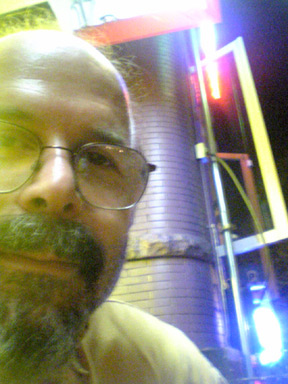7 | "A forest with a lake" [pantoum]
They say this used to be a forest with a lake
the dinasaurs would come and nibble at the leaves
now look at all the traffic here! oh for heaven's sake
the dinasaurs are gone and where's the man that grieves?
the dinasaurs would come and nibble at the leaves
the world was rather young I sat here even then
the dinasaurs are gone and where's the man that grieves?
none know except the stone remembering the glen
the world was rather young I sat here even then
when Hollywood and Vine grew literal with flora
none know except the stone remembering the glen
so few now recollect the kelly sylvan aura
when Hollywood and Vine grew literal with flora
our cinema were merely a sunset in the sky
so few now recollect the kelly sylvan aura
so many come and go while standing still am I
our cinema were merely a sunset in the sky
the lake was like a dream and now it is no more
so many come and go while standing still am I
we're silent in a row where once there was a shore
the lake was like a dream and now it is no more
the desert overwhelmed the snow forgot to flake
we're silent in a row where once there was a shore
they say this used to be a forest with a lake
=======
Pantoum beginning and ending with a line borrowed from Robert Creeley -- from "Eight Bollards" (1989; and included in the volume Windows (1990); for background story, see notes). An essay about Creeley's working methods and collaborations includes this note:
There are also compelling examples of interactions with contemporary sculptors. For the 1989 Los Angeles "Poet's Walk" project, Texas-based sculptor James Surls was given a list of poets he could work with on a public art project. To his delight, Creeley, whose writing he had long admired, was on the list. Surls invited Creeley to his home in the woods of East Texas; during a short stay, Creeley wrote a series of 24 poems. Surls, for his part, worked with series coordinator Kathy Lucoff in Los Angeles, finally choosing eight round granite bollards in front of the Citicorp building on which to inscribe the Creeley poems he had chosen and the drawings he had made to go with them. Surls' drawings are clean and simple, achieving the same clear distillations present in the brief verses.I have my own small postscript to add. I had become aware of the bollards project in the early 1990s (from the poem in the book -- plus hearing Creeley read the verses in Washington, DC). These verses later came to mind when perusing an invitation for installation proposals for a summer arts festival in Atlanta. I thought about a film and installation and music project based around Creeley's bollards verses and involving the images from Surls' related sculptural work. I lined up some possible collabors (the musician Malcolm Goldstein, the choreographer Robin Bisio), and I communicated with both Creeley and Surls about this notion. They were both game and amiable, and I drew up the proposal for funding. But the proposal (one lost among God only knows how many such) was not selected, the project was shelved, time passed, I lost track of it. Eventually Robert Creeley passed away (March 30, 2005). On my way to India last fall, I stopped in Manhattan just long enough to catch the ending portion of a marathon memorial reading for the poet (held at the St. Marks Poetry Project). If there's a take-home lesson for me in this recollection, it involves something about finding or focusing on ways of making art that are not dependent on the whims and fiats of (e.g.) juried-selection patronage.
At any rate, I retain a fondness for Creeley's spare bollards verses. The above playful pantoum may not do them much adequate justice; but at least it draws a frame around one of them and proceeds, fancifully, to embellish its thought. The speaker in this poem (as in the original four-short-line verse that, here, appears as a line [the first and last] of the Pantoum) is understood to be the granite steele (in form of a stylized bollard) whereon that verse is inscribed. If the stone could speak.
A bollard, of course, is a wooden post associated with a pier. I believe the conception of these stone bollards would involve the idea of a petrified wooden post that had (thus) become stone. Or that's one line of thought -- tied in with the idea that there, in the middle of downtown Los Angeles (a city built amid what had long been a desert area, though irrigated by recent ingenuity), there had been, in more primordial times, water. The introduction of dinasaurs to the scene (none are found in Creeley's 24 verses) more or less derives from my childhood visits to the La Brea Tar Pits in Los Angeles.
"We're silent in a row" may be understood to point to the sequence of eight bollards in the outdoor sculpture/poetry/conceptual art project -- modest stone pillars arrayed like artifacts from a vanished pier, erstwhile edging into primordial waters.
This is no. 7 in a sequence, Early Autumn Pantoums:
no. 1: "The sundial smiled"
no. 2: "In the school of disquietude"
no. 3: "With your full-moon heart"
no. 4: "At the autumn equinox"
no. 5: "One side of the heart"
no. 6: "The stream of notes"


0 Comments:
Post a Comment
<< Home